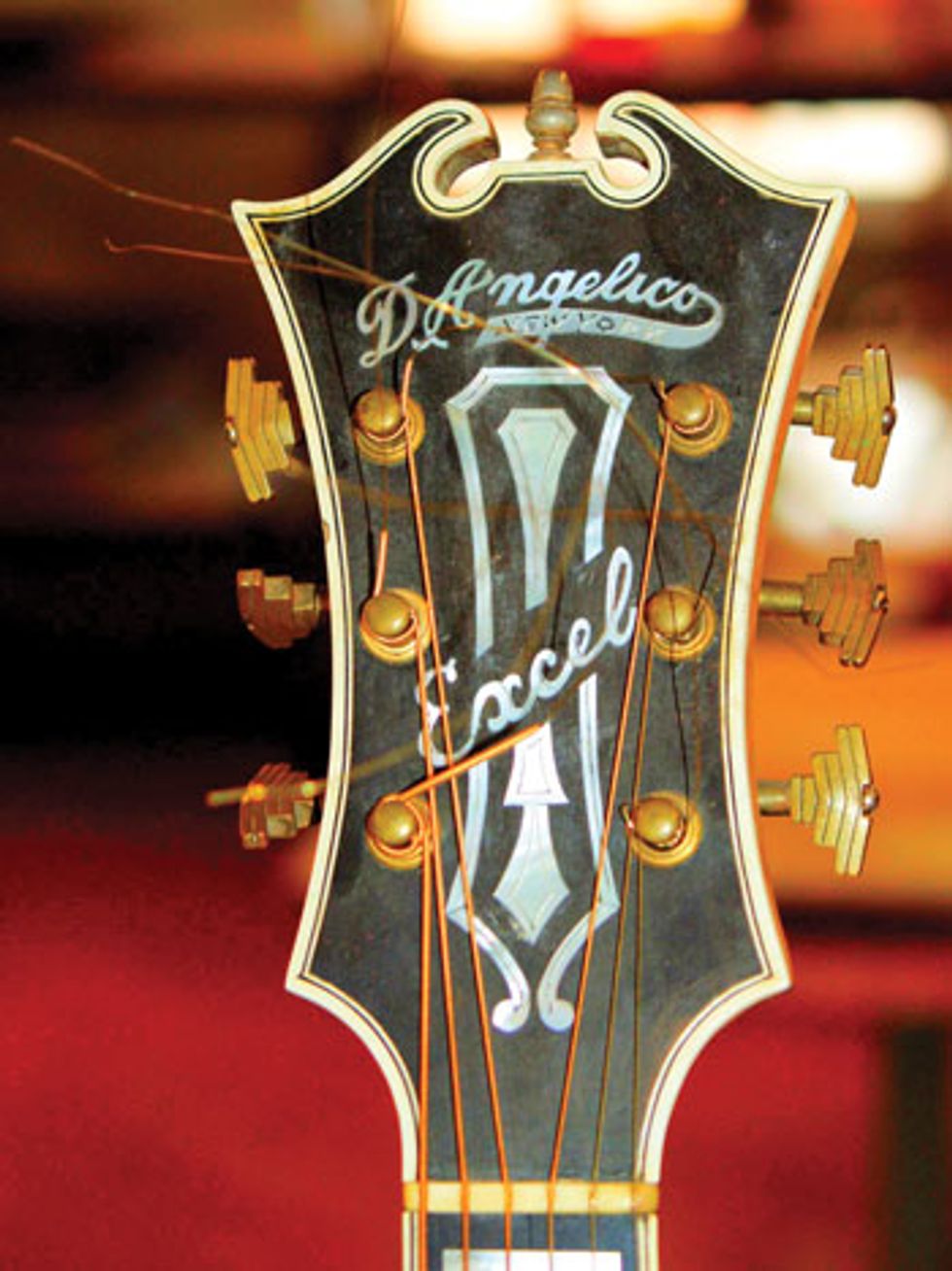
Shown here is the headstock from a 1937 D’Angelico Excel. At first glance, some players might be confused by the seemingly crude construction of these vintage masterpieces.
With an unfiltered Camel perched on his lower lip, he crouched before the family spinet. On the side of the keyboard, a tumbler of bourbon rippled slightly as his hands caressed the chords to “Dear Landlord.” At the age of 16, I wasn’t a big Dylan fan yet. But as Laurence sang the words, I was beginning to understand much more than just this song. There was such confidence in his voice that any imperfection in pitch or tone was not only overlooked, but also seemed to add urgency to the unfolding story. It was here, in the home of my best friend Philip, that I began to understand what makes perfect art.
Philip, Laurence, and their four brothers had moved to Chicago from Houston. Sons of a college professor and war hero, their household was a repository of alternative culture in our neighborhood—a wood paneled enclave full of books and music. Their mother was always humming to herself while flying around the kitchen, the room where I learned what great Mexican food was all about.
I introduced these friends to Hendrix, Humble Pie, The Who, and Bukowski in exchange for an immersion in Miles, Monk, Ornette Coleman, and Kerouac. And my sense of melody, harmony, and rhythm evolved with their influence before our worlds collided in 1971 at the intersection of the Mahavishnu Orchestra. Listening to the polyrhythmic chaos of this seminal band challenged ideas about what made a guitar solo great. Intonation be dammed, John McLaughlin played his guitar as though it was a percussion instrument. It truly was perfection of a different kind.
Over time, I’ve become fond of what some might call imperfection. It might be a flubbed note on Live at Leeds, or a semitone of flatness on a Neil Young vocal. While I’m not a big fan of Yes, I noted the unabashed fret buzz with satisfaction from Trevor Rabin’s intro to the 1987 hit, “Shoot High, Aim Low.” My ears pricked up with delight when I noticed Billy Gibbons searching for harmonics in “La Grange.” And the Hendrix catalog is a veritable manual of industrial guitar “malfunctions” presented as art. These little deviations kept me returning for additional listens.
Just like the music they are intended to make, it’s the same for the instruments themselves. A quick scan of a vintage D’Angelico may puzzle some players because of the seemingly crude construction. When presented with the task of restoring a 1937 Excel, I was constantly reminded that the imprint of the master’s hands was on the piece. It was as though the man himself had left a trail of breadcrumbs or footprints. Centerlines didn’t line up exactly and shimming was apparent within the neck joint. But these were the things that made it what it was—a booming, bellowing, and legendary piece. Once I opened up the body, I wondered if I could swab it for D’Angelico’s DNA before carefully putting things back in place, warts and all.
Another time, I had a well-known guitarist praise the playability and sound of my work. He told me the new guitar I had built for him was the best he’d ever played, and that he wanted another. Only this time, he wanted the finish to be as thin as his vintage guitars. When I explained that the finish on his guitar was only .007" thick, he refused to believe me. He was certain that the dead-flat, high-gloss finish I’d labored to achieve meant that it was “glopped on like a bowling ball.” It may have been that moment when I started to realize something: At a certain point, perfection actually diminishes the appreciation of the effort required to achieve it.
I think it’s unfortunate that the guitar boom has turned instrument building into an arms race instead of a craft. As much as I admire quality and precision, I draw the line when it erases personality. A guitar isn’t a toaster and it deserves a better gestation than a mere appliance. I know I’m not alone with this thought, and it may help explain the fascination with vintage instruments. Although guitars from the 1950s were made in larger quantities than the heyday of D’Angelico production, they certainly display a wider range of character than many of today’s guitars. Even their battle scars help make them unique and interesting. Of course, there are modern production guitars that emulate this—a kind of “distressed blue jeans” approach to introduce the notion of personality into a “Stepford wife” instrument. It’s clever, but not artful. Art and craft take thought, and require a depth that scratches more than just the surface. It’s all about context for the content.
The discovery of the builder’s subtext leads to a greater understanding and appreciation of the whole. It’s true in music, and it’s true in most every other creative endeavor. Once your antenna is up and able to receive messages beyond the obvious, things really get interesting. It no longer surprises me that Thelonious Monk labored for years by practicing dissonant chords for just the right delivery and effect. In the end, perfection of an ordered kind is easy, because there is a simple goal. Just like doing the dishes, you scrub until they are clean. Leaving stylistic breadcrumbs on your work is infinitely more difficult than polishing it into sterility.
 Jol Dantzig is a
noted designer, builder,
and player who co-founded
Hamer Guitars,
one of the first boutique
guitar brands, in 1973.
Today, as the director of
Dantzig Guitar Design, he continues to
help define the art of custom guitar. To
learn more, visit guitardesigner.com.
Jol Dantzig is a
noted designer, builder,
and player who co-founded
Hamer Guitars,
one of the first boutique
guitar brands, in 1973.
Today, as the director of
Dantzig Guitar Design, he continues to
help define the art of custom guitar. To
learn more, visit guitardesigner.com.













